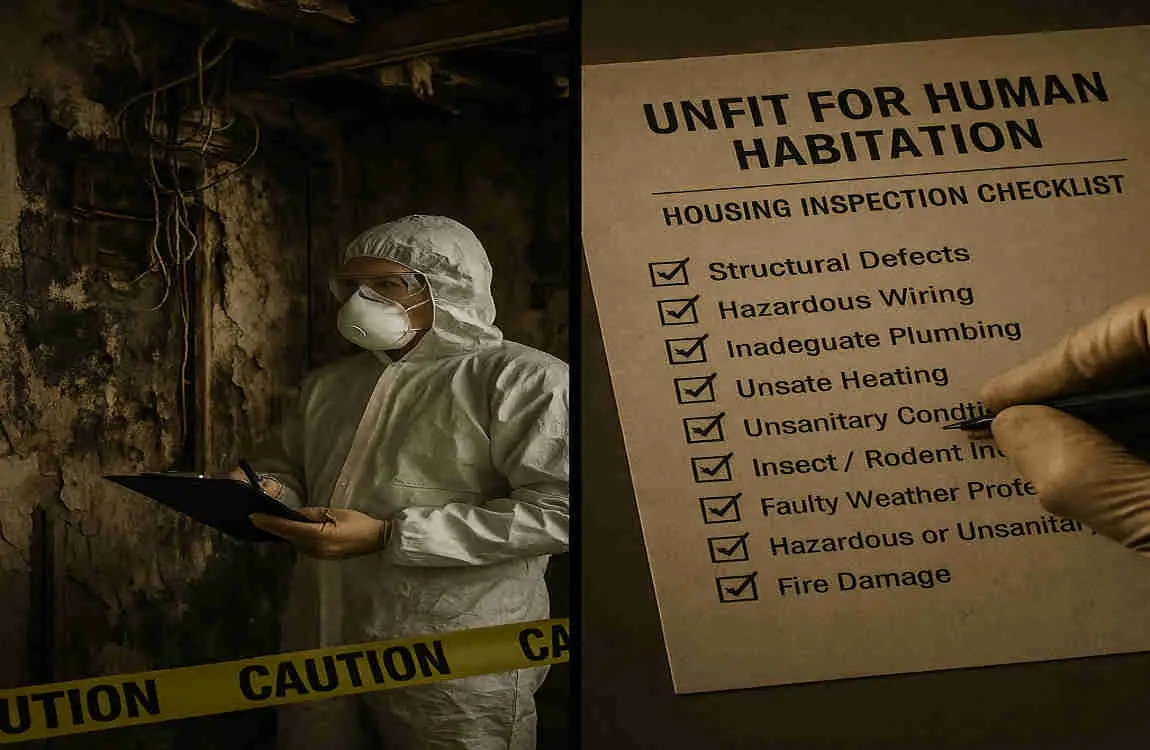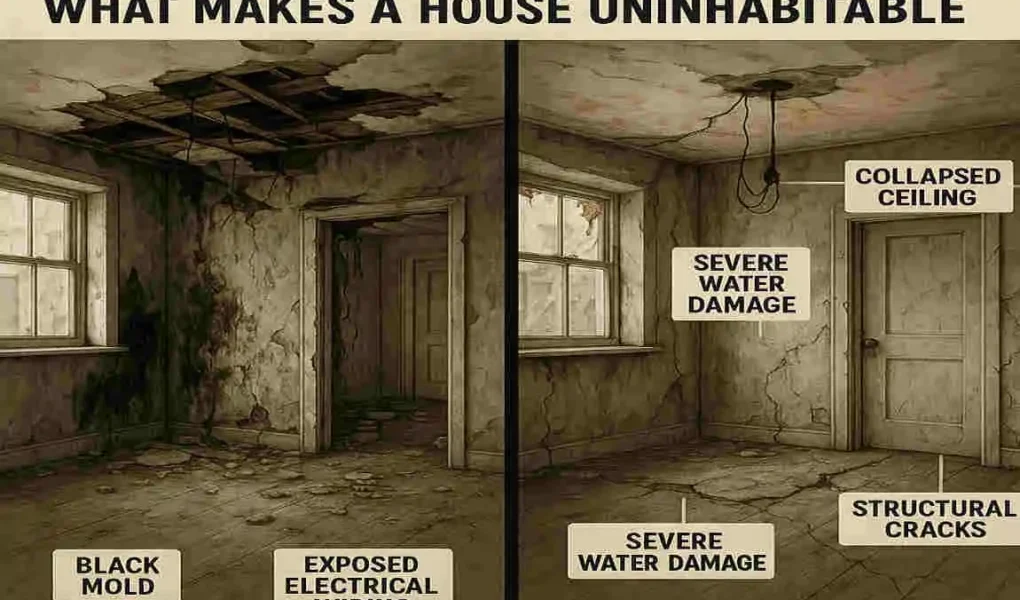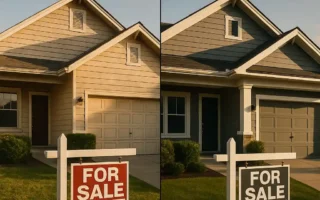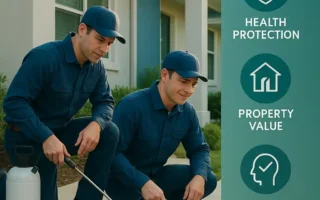Your home should be your haven, a place where you and your family can live comfortably and securely. But what happens when a house becomes dangerous to live in? Understanding what makes a house unfit for human habitation is crucial knowledge that every homeowner, renter, landlord, and property manager needs to have.
When we talk about an uninhabitable home, we’re referring to a dwelling that poses serious risks to the health, safety, or well-being of its occupants. It’s not just about a leaky faucet or peeling paint – we’re talking about conditions that make it genuinely unsafe to continue living in the property.
Think about it: you spend most of your time at home. If your living space harbors hidden dangers or lacks necessities, it can seriously impact your quality of life and even threaten your Survival. That’s why understanding what makes a house unfit for human habitation matters so much.
What Does “Unfit for Human Habitation” Mean?

When authorities declare a house “unfit for human habitation,” they’re making a serious legal determination that the property fails to meet minimum standards for safe living. But what exactly does this term mean, and who gets to make this call?
The legal definition varies somewhat between jurisdictions, but the core concept remains consistent. A dwelling is considered unfit when it contains conditions that pose immediate threats to the health, safety, or welfare of its occupants. This isn’t about aesthetic preferences or minor inconveniences – we’re talking about fundamental failures that make the space genuinely dangerous.
Legal Standards and Variations
Different states, counties, and cities may have slightly different criteria, but most follow similar guidelines. Generally, housing authorities look for violations of:
- Building codes that ensure structural integrity
- Health codes that protect against disease and contamination
- Safety codes that prevent fires and accidents
- Habitability standards that guarantee basic living necessities
For example, in California, the implied warranty of habitability requires landlords to maintain rental properties in a livable condition. Meanwhile, in New York, the Housing Maintenance Code sets specific standards that all residential buildings must meet.
Minor Issues vs. Complete Uninhabitability
It’s essential to understand the difference between minor property issues and conditions that render a home truly uninhabitable. A dripping faucet or squeaky floorboard doesn’t make a house unfit. However, when problems accumulate or become severe enough to threaten health and safety, that’s when authorities step in.
Minor issues might include:
- Cosmetic damage like chipped paint
- Small plumbing leaks
- Minor electrical problems in non-essential areas
Uninhabitable conditions include:
- No running water or functioning toilets
- Severe structural damage threatening collapse
- Extensive mold growth affecting air quality
- No heat during the winter months
The Declaration Process
When housing inspectors or health departments formally declare a property unfit, they issue official notices that may include:
- Condemnation orders requiring immediate evacuation
- Repair deadlines with specific violations listed
- Occupancy limits restricting who can enter the property
- Legal consequences for non-compliance
Understanding these definitions and processes is critical because they affect your rights, responsibilities, and options when dealing with substandard housing conditions.
Common Causes That Make a House Uninhabitable
Now let’s examine the specific conditions that can transform a home from a shelter into a hazard. These problems often start small but can quickly escalate into serious threats if left unaddressed.
Structural Problems
The bones of your house – its foundation, walls, and roof – must remain sound to keep you safe. When these fundamental elements fail, the entire structure becomes a danger zone.
Foundation Failures
Your home’s foundation literally holds everything up. When it develops severe cracks, shifts, or begins to crumble, the entire house becomes unstable. You might notice:
- Doors and windows that won’t close properly
- Visible cracks running up walls
- Floors that slope or feel uneven
- Gaps between walls and ceilings
These aren’t just cosmetic issues. A failing foundation can lead to sudden collapses, making the home immediately uninhabitable.
Roof Deterioration
A compromised roof does more than just let in a little rain. Extensive roof damage can:
- Allow water to pour in, destroying everything below
- Create conditions for dangerous mold growth
- Weaken the overall structure
- Expose occupants to the elements
When large sections of roofing material are missing or the underlying structure shows signs of rot, the house cleaning becomes unsafe for occupation.
Wall Integrity Issues
Walls do more than divide spaces – they’re crucial load-bearing elements. Major problems include:
- Deep cracks that go through the entire wall
- Bulging or bowing walls
- Walls are pulling away from the foundation
- Visible rot in wooden frame walls
These conditions signal imminent danger and require immediate attention.
Environmental Hazards
Sometimes the most dangerous conditions in a home are the ones you can’t see. Environmental hazards can silently threaten your health while you go about your daily life.
Toxic Mold Infestations
Mold isn’t just unsightly – extensive growth can make a home genuinely uninhabitable. Black mold and other toxic varieties release spores that can cause:
- Severe respiratory problems
- Chronic headaches and fatigue
- Allergic reactions
- Long-term health complications
When mold covers large areas or grows inside walls and HVAC systems, professional remediation becomes essential.
Lead and Asbestos Dangers
Older homes often contain these hazardous materials:
Lead paint becomes dangerous when it:
- Chips or peels, creating dust
- Contaminates the soil around the home
- Affects water through lead pipes
Asbestos poses risks when:
- Insulation becomes damaged or friable
- Floor tiles crack and release fibers
- Roof shingles deteriorate
Both substances require professional handling and can render a home uninhabitable during remediation.
Invisible Gas Threats
You can’t see or smell all the dangerous gases. Radon seeping from the ground and carbon monoxide from faulty appliances can reach lethal levels without warning. Homes with:
- High radon readings above 4 pCi/L
- Malfunctioning heating systems producing CO
- Poor ventilation traps dangerous gases
These conditions require immediate intervention to restore habitability.
Plumbing and Electrical Failures
Modern life depends on functioning utilities. When these systems fail catastrophically, a home quickly becomes unlivable.
Electrical Hazards
Faulty wiring isn’t just inconvenient – it’s a fire waiting to happen. Dangerous electrical conditions include:
- Exposed wires or damaged insulation
- Overloaded circuits that regularly trip
- Outdated knob-and-tube wiring
- Burn marks around outlets
- Flickering lights throughout the house
Without safe electricity, you can’t maintain basic living standards or ensure your safety.
Plumbing Catastrophes
Water is essential for life, but plumbing failures can make a home uninhabitable through:
- No running water for drinking, cooking, or hygiene
- Sewage backups are contaminating living spaces
- Frozen pipes bursting and flooding rooms
- Contaminated water supplies are unfit for use
Plumbing Issue, Health Risk, Habitability Impact
No water supply , Dehydration, poor hygiene , Immediate uninhabitability
Sewage backup , Disease, contamination, requires evacuation
Significant leaks , Mold growth, structural damage , Progressive deterioration
Contaminated water, Poisoning, illness. Cannot use water systems
Heating System Failures
In cold climates, a functioning heating system isn’t a luxury – it’s a necessity. Homes become uninhabitable when:
- Furnaces completely fail during winter
- Heating systems produce carbon monoxide
- Insulation is so poor that pipes freeze regularly
- No alternative heating sources exist
Sanitation and Waste Issues
Basic sanitation separates livable homes from health hazards. When these systems fail, conditions quickly become unbearable and dangerous.
Toilet and Bathroom Failures
Imagine life without a functioning toilet. Homes lacking proper sanitation facilities face:
- Immediate health code violations
- Risk of disease transmission
- Inability to maintain basic hygiene
- Accumulation of human waste
Even one day without working toilets can render a home uninhabitable, especially for families with children or elderly members.
Garbage Accumulation
When waste management breaks down, homes can quickly become hazardous to the environment. Excessive garbage:
- Attracts rats, roaches, and other disease carriers
- Creates fire hazards, blocking exits
- Produces toxic fumes and odors
- Breeds bacteria and pathogens
Hoarding situations often escalate to this level, requiring professional intervention.
Sewage Contamination
Nothing makes a home uninhabitable faster than raw sewage in living spaces. This occurs through:
- Backed-up septic systems
- Broken sewer lines
- Flooding that brings sewage inside
- Improper waste disposal
The health risks are immediate and severe, requiring evacuation until professional cleanup is complete.
Fire Safety and Security Concerns
A habitable home must provide basic safety from both fires and intruders. When these protections fail, occupants face unacceptable risks.
Fire Safety Failures
Your home should protect you from fires, not increase the risk. Critical fire safety issues include:
Missing or non-functional:
- Smoke detectors in bedrooms and hallways
- Carbon monoxide detectors near sleeping areas
- Fire extinguishers in the kitchen and garage
- Clear exits from every room
Blocked escape routes create deadly traps during emergencies. Homes with:
- Windows painted or nailed shut
- Doors blocked by debris
- Only one exit from the upper floors
- Bars on windows without quick releases
These conditions violate fire codes and make homes legally uninhabitable.
Security Vulnerabilities
While a broken lock might seem minor, severe security issues can make a home uninhabitable:
- Missing exterior doors leave homes open to elements and intruders
- Broken windows that can’t be secured
- Structural damage creates easy entry points
- Neighborhood conditions make the property inherently unsafe
You have the right to feel secure in your home. When basic security is impossible, the property fails habitability standards.
Health Impacts of Living in Uninhabitable Homes
Living in substandard conditions doesn’t just affect your comfort – it can seriously damage your health. Let’s explore how uninhabitable housing creates both immediate and long-term health problems.
Respiratory Illnesses
Your lungs bear the brunt of poor housing conditions. Mold spores, dust from deteriorating materials, and poor ventilation create a toxic cocktail that can cause:
- Chronic asthma that worsens over time
- Persistent coughing and wheezing
- Increased susceptibility to respiratory infections
- Development of severe conditions like COPD
Children exposed to these conditions often develop lifelong breathing problems. Their developing lungs are particularly vulnerable to environmental hazards.
Physical Injury Risks
Structural problems create accident zones throughout uninhabitable homes:
- Collapsing ceilings can cause head trauma
- Rotting floors lead to falls and broken bones
- Exposed wires result in electrical burns or shocks
- Unstable stairs cause serious tumbles
Emergency room visits spike among residents of substandard housing, with injuries ranging from minor cuts to life-threatening accidents.
Mental Health Consequences
Don’t underestimate the psychological toll of living in dangerous conditions. Residents often experience:
- Chronic stress from constant worry about safety
- Depression linked to poor living conditions
- Anxiety about health impacts on family members
- Sleep disorders from noise, temperature extremes, or fear
Children in these environments show higher rates of behavioral problems and learning difficulties, impacts that can last a lifetime.
Disease Transmission
Uninhabitable conditions create perfect breeding grounds for illness. Poor sanitation and pest infestations lead to:
- Gastrointestinal diseases from contaminated water
- Skin infections from unsanitary conditions
- Vector-borne diseases from rodents and insects
- Increased spread of contagious illnesses
These health impacts compound over time, making it crucial to address habitability issues quickly.
How Authorities Determine a House Is Unfit for Human Habitation

When concerns arise about a property’s habitability, a formal process determines whether it meets minimum standards. Understanding this process helps you know what to expect and how to respond.
The Inspection Process
Building inspectors and health department officials follow systematic procedures:
- Initial complaint or referral triggers an inspection
- Scheduled visit with proper notice (except emergencies)
- Comprehensive walkthrough documenting all issues
- Testing for specific hazards like lead or mold
- Written report detailing all violations found
Inspectors use detailed checklists covering:
- Structural integrity
- Electrical and plumbing systems
- Fire safety equipment
- Sanitation facilities
- Environmental hazards
Enforcement Actions
Based on inspection findings, authorities can issue various orders:
Repair notices specify:
- Exact violations found
- Required corrections
- Compliance deadlines
- Re-inspection schedules
Condemnation orders for severe cases include:
- Immediate evacuation requirements
- Posting of official notices
- Utility disconnection orders
- Legal penalties for non-compliance
Rights and Responsibilities
Both tenants and landlords have specific rights during this process:
Tenant rights include:
- Requesting inspections for dangerous conditions
- Receiving copies of inspection reports
- Withholding rent in some jurisdictions
- Breaking leases without penalty for uninhabitable conditions
Landlord obligations involve:
- Making required repairs within specified timeframes
- Providing temporary housing in some cases
- Maintaining habitable conditions
- Facing fines or criminal charges for non-compliance
Understanding these roles helps everyone navigate the process more effectively.
What to Do If Your House Is Declared Unfit
Receiving notice that your home is uninhabitable can be overwhelming. Here’s a practical roadmap for moving forward.
Immediate Steps for Safety
Your priority is protecting yourself and your family:
- Evacuate if ordered – Don’t risk staying in condemned property
- Secure temporary housing – Contact family, friends, or local services
- Document everything – Take photos and keep all official notices
- Contact your insurance – Many policies cover temporary relocation
Beginning the Repair Process
For homeowners facing repair orders:
- Hire licensed professionals for major work
- Get multiple estimates to understand costs
- Pull required permits before starting work
- Schedule re-inspections as work progresses
Create a repair timeline that prioritizes addressing the most serious issues first, while working toward full compliance.
Available Resources and Assistance
You don’t have to face this alone. Help is available through:
Financial assistance programs:
- HUD rehabilitation loans
- State and local grant programs
- Non-profit housing organizations
- Emergency repair funds
Professional services:
- Legal aid for tenant rights
- Housing counselors for guidance
- Contractor referral services
- Code compliance consultants
Resolving Disputes
Sometimes disagreements arise about habitability determinations. Your options include:
- Appealing inspection findings through proper channels
- Requesting second opinions from qualified professionals
- Mediation services to resolve landlord-tenant disputes
- Legal action when other methods fail
Document everything throughout this process to protect your interests.
Preventing Your House from Becoming Uninhabitable
The best approach to addressing uninhabitable housing is to prevent it from happening. Regular maintenance and early intervention can save you from major problems down the road.
Regular Maintenance Essentials
Stay ahead of problems with routine care:
Monthly tasks:
- Test smoke and CO detectors
- Check for water leaks
- Clean HVAC filters
- Inspect for pest activity
Annual professional inspections:
- Roof and chimney evaluation
- HVAC system servicing
- Electrical safety checks
- Plumbing system review
Early Warning Signs
Watch for these red flags that signal developing problems:
- Musty odors indicate hidden mold
- New cracks in walls or foundations
- Increased utility bills suggest system failures
- Water stains on ceilings or walls
- Unusual sounds from structural settling
Acting quickly when you notice these signs can prevent minor issues from becoming significant hazards.
Professional Help
Know when to call in experts:
- Structural engineers for foundation concerns
- Certified mold inspectors for air quality issues
- Licensed electricians for wiring problems
- Qualified plumbers for water system failures
The cost of professional intervention is always less than dealing with an uninhabitable property.




